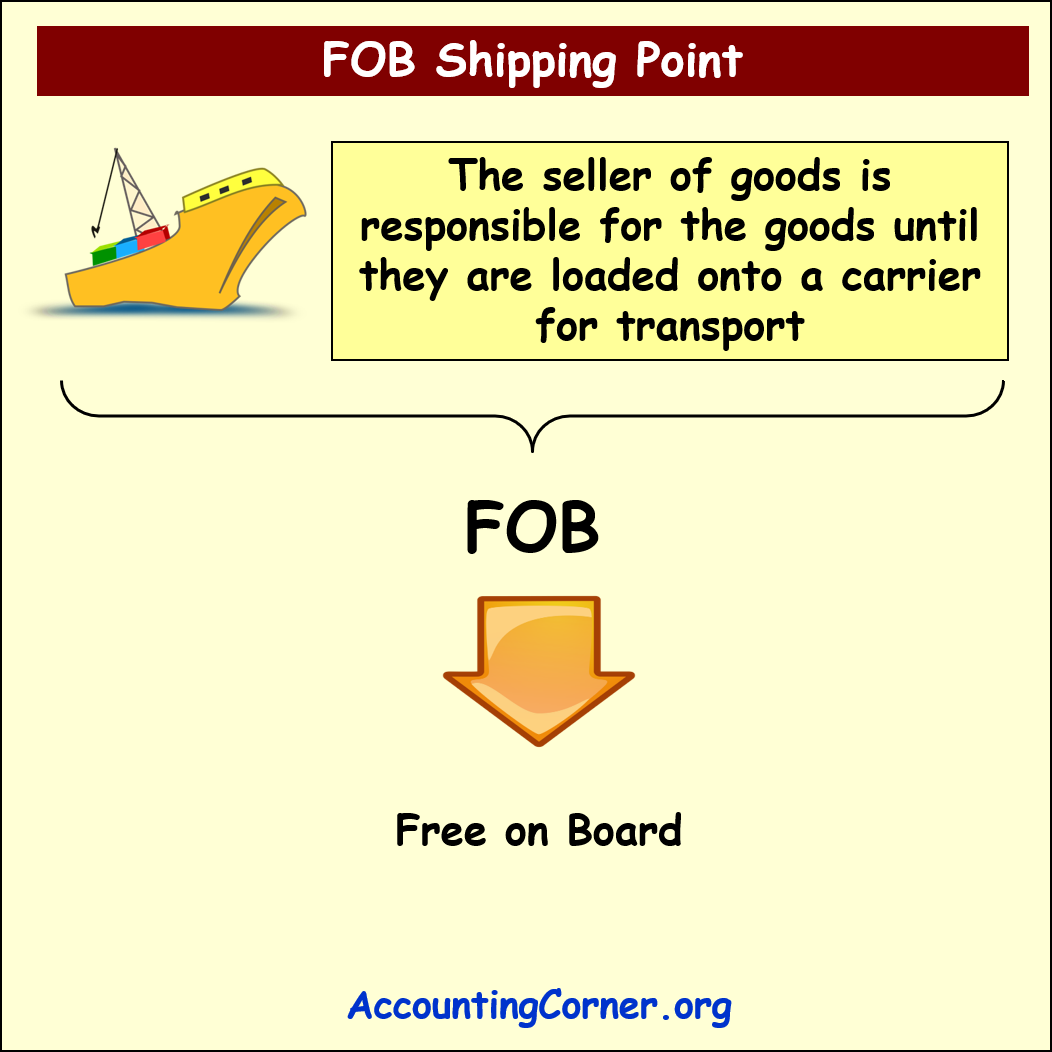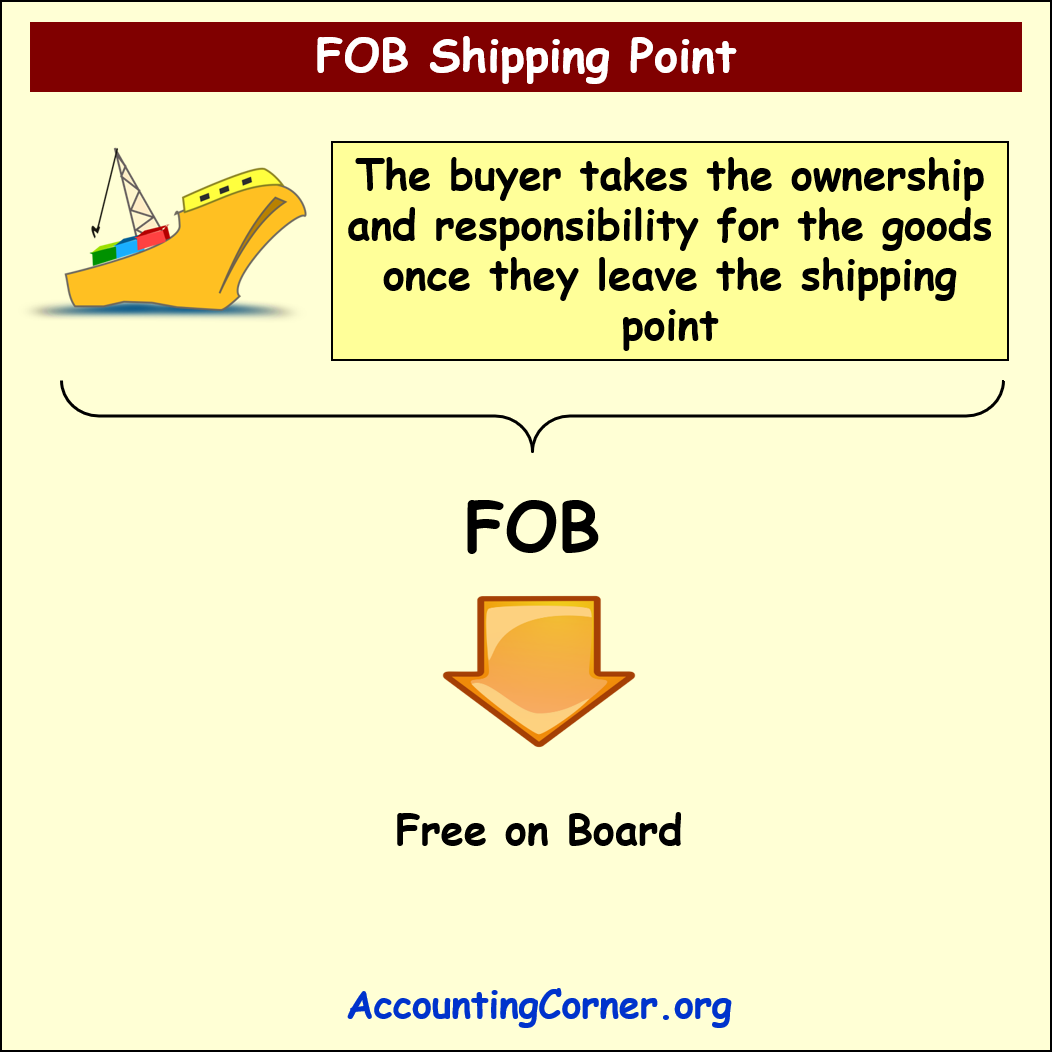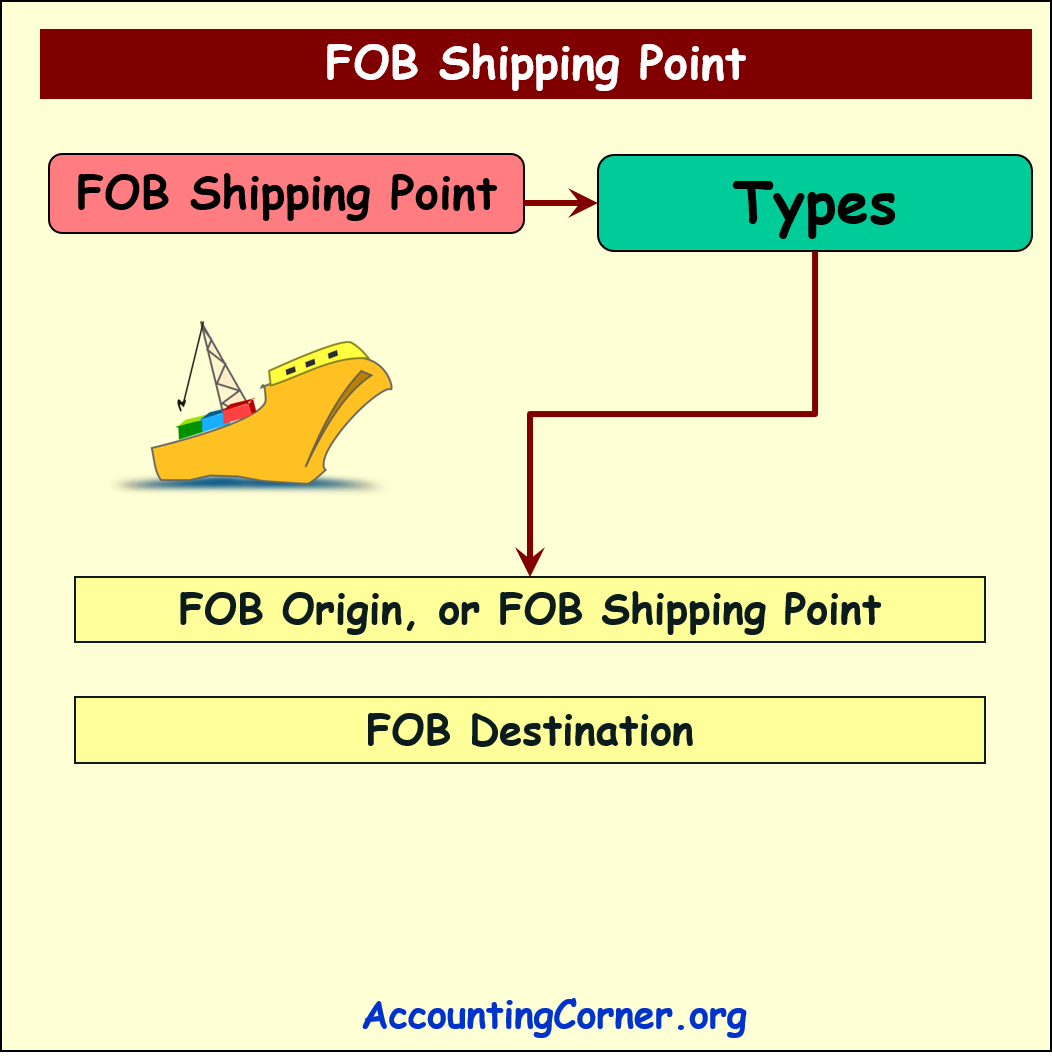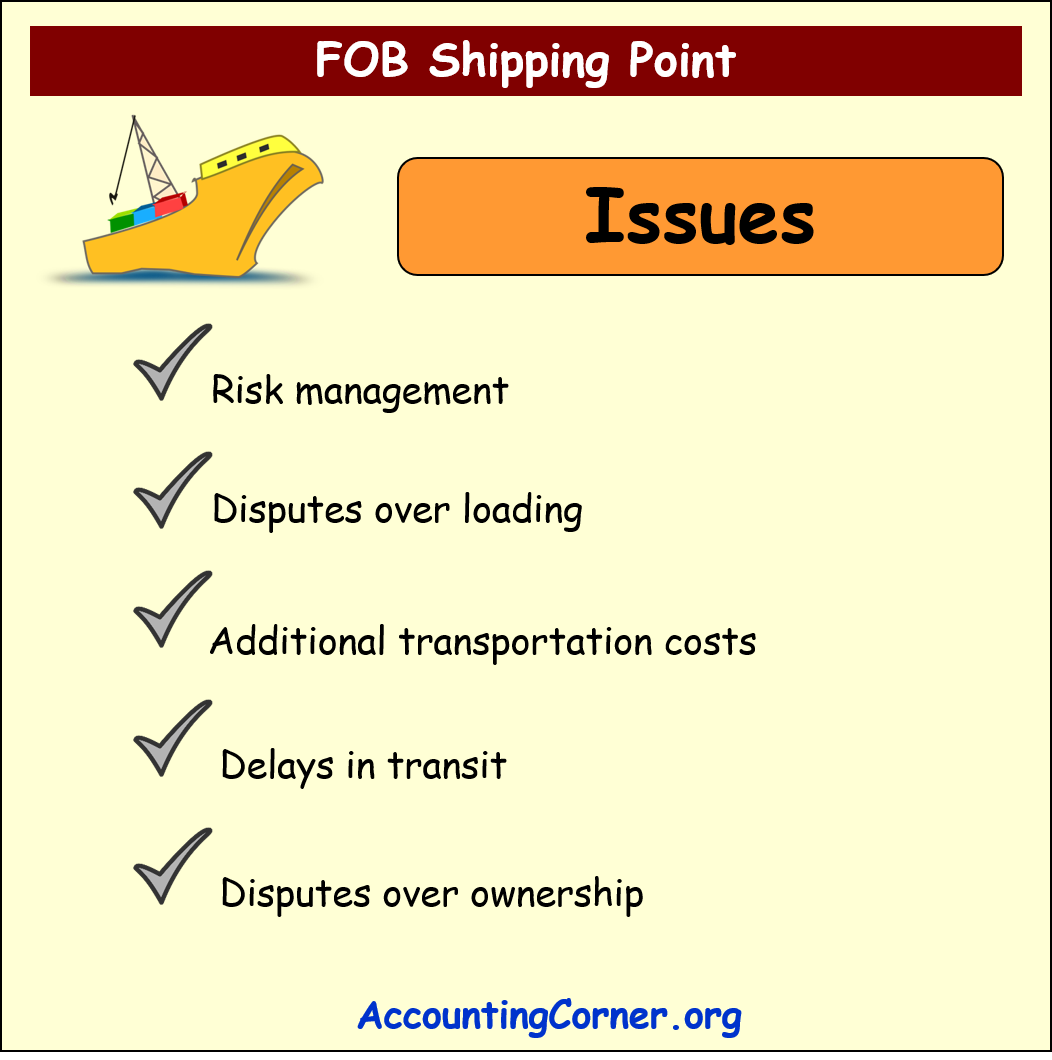FOB shipping point definition
 FOB shipping point is a term used in the transportation and logistics industry to indicate, that the seller of goods is responsible for the goods until they are loaded onto a carrier for transport.
FOB shipping point is a term used in the transportation and logistics industry to indicate, that the seller of goods is responsible for the goods until they are loaded onto a carrier for transport.

FOB abbreviation stands for “Free on Board,” and shipping point refers to the location, where the goods are loaded onto the carrier.
 In other words, when a seller specifies FOB shipping point, it means, that the buyer takes the ownership and responsibility for the goods once they leave the shipping point. The seller is responsible and covers the cost of goods loading onto the transport mean. Seller is also responsible for any damages, which may occur before the goods are loaded onto the transportation.
In other words, when a seller specifies FOB shipping point, it means, that the buyer takes the ownership and responsibility for the goods once they leave the shipping point. The seller is responsible and covers the cost of goods loading onto the transport mean. Seller is also responsible for any damages, which may occur before the goods are loaded onto the transportation.

After the goods are loaded, the buyer takes over responsibility for any loss or damage, which may occur to the goods during their transportation.

FOB shipping point is often contrasted with FOB destination, which means that the seller is responsible for the goods until they reach their destination, and the buyer assumes responsibility only once the goods have arrived.

FOB Shipping Point importance
FOB shipping point is important for both buyers and sellers in a transaction, because it determines the moment, when ownership and responsibility of the goods transfer from the seller to the buyer. Check below some key importance aspects of FOB shipping point:
- Clear allocation of responsibilities: By specifying FOB shipping point, the seller and buyer can clearly define their respective responsibilities for the goods during transportation. This helps avoiding any confusion or disputes about who is responsible for the goods at different stages of the shipment.
- Cost allocation: FOB shipping point can also affect the cost allocation for the shipment. When the seller is responsible for the goods until they are being transported to the shipping point, the seller is responsible for the associated costs of loading the goods onto the carrier. In situations, when the buyer takes over responsibility for the goods at the shipping point, the buyer is responsible for the associated costs, such as freight charges.
- Insurance coverage: FOB shipping point can also affect insurance coverage for the shipment. If the buyer assumes responsibility at the shipping point, the buyer needs to purchase insurance to cover the goods during transit. If the seller assumes responsibility up to the shipping point, the seller needs to purchase insurance to cover the goods until they are loaded onto the carrier.
- Risk management: FOB shipping point is an important consideration for risk management during transportation. In situations, where the buyer takes over responsibility at the shipping point, the buyer needs to take additional precautions to ensure the goods are protected during transit, such as hiring a reputable carrier and using appropriate packaging and labeling.

 FOB shipping point is an important consideration in international trade and can have significant implications for both buyers and sellers. It helps to clarify responsibilities, allocate costs, and manage risk during transportation.
FOB shipping point is an important consideration in international trade and can have significant implications for both buyers and sellers. It helps to clarify responsibilities, allocate costs, and manage risk during transportation.
FOB shipping point types
There are two main types of FOB shipping point:

- FOB Origin, also known as FOB Shipping Point: the buyer assumes ownership and responsibility for the goods as soon as they are loaded onto the carrier at the seller’s shipping point. Therefore, the buyer has to cover cost of goods transportation and accept any risk of loss or damage during transit. The seller is responsible for preparing the goods for shipment and loading them onto the carrier.
- FOB Destination: the seller assumes ownership and responsibility for the goods until they are delivered to the buyer’s destination. Therefore, the seller has to cover cost of goods transportation and accept any risk of loss or damage during transit. The buyer assumes ownership and responsibility for the goods once they arrive at the destination. The seller has to prepare the goods for shipment and deliver them to the buyer’s destination.
 There might be also other variations of FOB terms, i.e. as FOB vessel, FOB port, FOB airport, and others. These terms may specify a particular location as the point where ownership and responsibility for the goods transfer from the seller to the buyer.
There might be also other variations of FOB terms, i.e. as FOB vessel, FOB port, FOB airport, and others. These terms may specify a particular location as the point where ownership and responsibility for the goods transfer from the seller to the buyer.
It is essential to carefully review the terms and conditions of the sales agreement to determine the exact FOB terms that apply to the transaction.
FOB shipping point formula
The formula for calculating FOB shipping point is relatively simple and involves two main elements:
- Product cost: this is the price of goods, agreed between the buyer and seller. The price might also include cost of the product, taxes or duties, any other charges related to the product.
- Shipping costs: this is the cost of loading the goods onto the carrier at the FOB shipping point. These costs should also include any other transportation costs associated with the delivery of goods to the destination.

The formula for FOB shipping point is:
 For example, there is a seller in China, who sells goods to the buyer in the United States. Sales price is $1,000. The FOB shipping point is the port of Shanghai, and the cost of loading the goods onto the carrier at that point is $200. The formula for FOB shipping point would be:
For example, there is a seller in China, who sells goods to the buyer in the United States. Sales price is $1,000. The FOB shipping point is the port of Shanghai, and the cost of loading the goods onto the carrier at that point is $200. The formula for FOB shipping point would be:
 In this example the FOB price for the goods would be $1,200. The buyer would be responsible for any additional transportation costs and risks associated with the shipping of the goods from Shanghai to the final destination in the United States.
In this example the FOB price for the goods would be $1,200. The buyer would be responsible for any additional transportation costs and risks associated with the shipping of the goods from Shanghai to the final destination in the United States.
FOB shipping point examples
Below you can explore some examples of FOB shipping point:
 Example 1:
Example 1:
-
-
-
- a manufacturer in Germany agrees to sell a product to a distributor in France for €10,000 FOB shipping point Hamburg.
- The manufacturer is responsible for loading the goods onto the carrier in Hamburg.
- The distributor assumes responsibility for the goods and any associated transportation costs as they are loaded onto the carrier.
- If the distributor will carry the goods from Hamburg to Paris, the distributor will hire a freight forwarder for this transportation and in this case distributor will be responsible for paying the freight charges and other related costs.
-
-
 Example 2:
Example 2:
-
-
-
- a farmer in Brazil agrees to sell coffee beans to a roaster in the United States for $20,000 FOB shipping point Santos.
- The farmer is responsible for loading the beans onto the carrier in Santos, and
- the roaster assumes responsibility for the beans and any associated transportation costs once they are loaded.
- If the roaster will carry coffee rom Santos to New York, the roaster will hire a freight forwarder for this transportation and in this case the roaster will be responsible for paying the freight charges and other related costs.
-
-
In these examples FOB shipping point is applied to clarify the responsibilities of the partied and allocation of the costs associated with transporting goods between the seller and the buyer.
Issues & problems related to FOB shipping point
FOB shipping point can provide clarity and structure to the transportation of goods and determine responsibilities of the parties in the sales-purchases transactions, there are some potential issues and problems, which might arise:
- Risk management: Under FOB shipping point conditions, the buyer accepts responsibility for the goods once they are loaded onto the carrier at the shipping point. In this way buyer is responsible for managing any risks associated with transportation of goods, such as damage or loss of goods during transit. If the buyer fails to properly insure or protect the goods, financial losses might be incurred.
- Disputes over loading: FOB shipping point places the responsibility for loading the goods onto the carrier on the seller. However, there may be disputes over the condition of the goods or the loading process, which may delay or disrupt the shipment.
- Additional transportation costs: While FOB shipping point typically includes the cost of loading the goods onto the carrier at the shipping point, there may be additional transportation costs, which buyer must incur to transport the goods to their final destination. These costs may include fees for customs clearance, taxes, and other duties.
- Delays in transit: in case the goods are delayed during transit, the buyer may be responsible for any additional costs associated with such delay, such as storage fees or demurrage charges.
- Disputes over ownership: FOB shipping point can sometimes lead to disputes over ownership of the goods. In case there is a delay of delivery of goods or any other problem with the shipment, both buyer and seller may claim ownership of the goods, which subsequently would lead to legal disputes and delays in delivery.

 In order to mitigate these issues, for bot parties (seller and buyer) it is important for to have a clear understanding FOB agreement terms and conditions and efficiently communicate throughout the transportation process. It may also be beneficial to work with reputable carriers and logistics companies to help ensuring a smooth and successful shipment.
In order to mitigate these issues, for bot parties (seller and buyer) it is important for to have a clear understanding FOB agreement terms and conditions and efficiently communicate throughout the transportation process. It may also be beneficial to work with reputable carriers and logistics companies to help ensuring a smooth and successful shipment.
FOB shipping point: key finding & main aspects to remember
Definition:
- FOB shipping point is a term used in transportation and logistics to indicate, that the seller is responsible for the goods until they are loaded onto a carrier for transport.
Importance:
- FOB shipping point concept clarifies responsibilities and cost allocation between the buyer and seller for the goods during transportation.
- FOB shipping point concept determines, when ownership and responsibility for the goods transfer from the seller to the buyer.
- FOB shipping point concept can affect insurance coverage and risk management rules/procedures during transportation.
Types:
- FOB Origin: Buyer assumes responsibility for the goods once they are loaded onto the carrier at the seller’s shipping point.
- FOB Destination: Seller assumes responsibility for the goods until they are delivered to the buyer’s destination.
Process:
- Agree on FOB shipping point in sales agreement.
- Prepare goods for shipment and load them onto the carrier at the FOB shipping point.
- Obtain shipping documents and notify the buyer.
- Transfer ownership and responsibility to the buyer.
- Buyer receives the goods and inspects them for any damages or discrepancies.
Formula:
- FOB price = Product cost + Shipping costs at the FOB point.
Potential Issues/Problems:
- Risk management
- Disputes over loading
- Additional transportation costs
- Delays in transit
- Disputes over ownership
All visual material on FOB Shipping point
The Most Popular Accounting & Finance Topics:
- Balance Sheet
- Balance Sheet Example
- Classified Balance Sheet
- Balance Sheet Template
- Income Statement
- Income Statement Example
- Multi Step Income Statement
- Income Statement Format
- Common Size Income Statement
- Income Statement Template
- Cash Flow Statement
- Cash Flow Statement Example
- Cash Flow Statement Template
- Discounted Cash Flow
- Free Cash Flow
- Accounting Equation
- Accounting Cycle
- Accounting Principles
- Retained Earnings Statement
- Retained Earnings
- Retained Earnings Formula
- Financial Analysis
- Current Ratio Formula
- Acid Test Ratio Formula
- Cash Ratio Formula
- Debt to Income Ratio
- Debt to Equity Ratio
- Debt Ratio
- Asset Turnover Ratio
- Inventory Turnover Ratio
- Mortgage Calculator
- Mortgage Rates
- Reverse Mortgage
- Mortgage Amortization Calculator
- Gross Revenue
- Semi Monthly Meaning
- Financial Statements
- Petty Cash
- General Ledger
- Allocation Definition
- Accounts Receivable
- Impairment
- Going Concern
- Trial Balance
- Accounts Payable
- Pro Forma Meaning
- FIFO
- LIFO
- Cost of Goods Sold
- How to void a check?
- Voided Check
- Depreciation
- Face Value
- Contribution Margin Ratio
- YTD Meaning
- Accrual Accounting
- What is Gross Income?
- Net Income
- What is accounting?
- Quick Ratio
- What is an invoice?
- Prudent Definition
- Prudence Definition
- Double Entry Accounting
- Gross Profit
- Gross Profit Formula
- What is an asset?
- Gross Margin Formula
- Gross Margin
- Disbursement
- Reconciliation Definition
- Deferred Revenue
- Leverage Ratio
- Collateral Definition
- Work in Progress
- EBIT Meaning
- FOB Meaning
- Return on Assets – ROA Formula
- Marginal Cost Formula
- Marginal Revenue Formula
- Proceeds
- In Transit Meaning
- Inherent Definition
- FOB Shipping Point
- WACC Formula
- What is a Guarantor?
- Tangible Meaning
- Profit and Loss Statement Template
- Revenue Vs Profit
- FTE Meaning
- Cash Book
- Accrued Income
- Bearer Bonds
- Credit Note Meaning
- EBITA meaning
- Fictitious Assets
- Preference Shares
- Wear and Tear Meaning
- Cancelled Cheque
- Cost Sheet Format
- Provision Definition
- EBITDA Meaning
- Covenant Definition
- FICA Meaning
- Ledger Definition
- Allowance for Doubtful Accounts
- T Account / T Accounts
- Contra Account
- NOPAT Formula
- Monetary Value
- Salvage Value
- Times Interest Earned Ratio
- Intermediate Accounting
- Mortgage Rate Chart
- Opportunity Cost
- Total Asset Turnover
- Sunk Cost
- Housing Interest Rates Chart
- Additional Paid In Capital
- Obsolescence
- What is Revenue?
- What Does Per Diem Mean?
- Unearned Revenue
- Accrued Expenses
- Earnings Per Share
- Consignee
- Accumulated Depreciation
- Leashold Improvements
- Operating Margin
- Notes Payable
- Current Assets
- Liabilities
- Controller Job Description
- Define Leverage
- Journal Entry
- Productivity Definition
- Capital Expenditures
- Check Register
- What is Liquidity?
- Variable Cost
- Variable Expenses
- Cash Receipts
- Gross Profit Ratio
- Net Sales
- Return on Sales
- Fixed Expenses
- Straight Line Depreciation
- Working Capital Ratio
- Fixed Cost
- Contingent Liabilities
- Marketable Securities
- Remittance Advice
- Extrapolation Definition
- Gross Sales
- Days Sales Oustanding
- Residual Value
- Accrued Interest
- Fixed Charge Coverage Ratio
- Prime Cost
- Perpetual Inventory System
- Vouching
Return from FOB Shipping Point to AccountingCorner.org home
Should you wish to learn more – check FOB shipping point Investopedia.